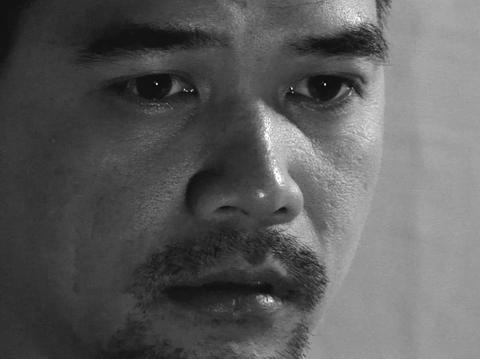On a number of home movie screens assembled to form one large screen, footage from World War II movies from the era depict Japanese as brutes and killers. Across from it, an old TV set plays a compilation of commercials from the 1950s.
The video installation, titled Environmental, serves as a telling introduction to An Asian Survey — Bruce Yonemoto (亞洲調查 — 布魯斯米本個展), the first solo exhibition of Japanese-American artist Bruce Yonemoto in Taiwan, currently on view at Hong Gah Museum (鳳甲美術館).
A multimedia artist and art professor, Yonemoto is noted for exploring issues of representation, identity and memory. His focus is on mass media, its pervasive manipulation of reality and fantasy and how it constantly constructs, formulates and mutually informs our desires and notions of identity, both personal and collective.

Photo courtesy of Hong Gah Museum
For Yonemoto, such topics are not abstract. He was born in the immediate post-World War II period and grew up in California. His parents were among the more than 120,000 Japanese-Americans incarcerated in internment camps during the war, and, following the war, re-assimilated into American society.
Environmental (2013) reflects on the artist’s childhood in the 1950s, a time when “every family had a screen at home to watch home movies or slide shows.”
“That is the immediate environment in which I was raised as a child, which, of course, was a very perverse environment because the Japanese were villains. They were the enemies,” Yonemoto says. “But what can I do? I was just a child watching TV.”

Photo courtesy of Hong Gah Museum
Yonemoto began his artistic career in the 1970s working with his brother Norman Yonemoto, who recently passed away. Their collaborations, which took place over the course of two decades, saw the Yonemoto brothers create an impressive array of films and video works that often appropriated the visual vernacular of Hollywood melodrama, television advertising and other popular forms to expose, deconstruct and subvert mass-media archetypes and cliches.
Kappa (1986), for example, is a provocative video that takes an ironic and sometimes hilarious look at Sigmund Freud’s psychosexual development theory by juxtaposing the Oedipal myth with the legend of kappa, a mischievous Japanese water imp.
The work stars Mike Kelley, an American contemporary artist who committed suicide in 2012, as the kappa. American actress and painter Mary Woronov plays a mother/vamp figure — one that wouldn’t look out of place in a Hollywood exploitation movie.

Photo courtesy of Hong Gah Museum
“But it you apply Freud’s psychoanalysis to the kappa myth, it becomes very comic very quickly. Kappa’s favorite food is cucumber, and he molests young girls in the toilet. All these things are very Freudian cliches,” the Los Angeles-based artist says.
In the small retrospective in Taipei, Yonemoto’s examinations on the interplay between American pop culture and pan-Asian identities create an intriguing motif.
NSEW (2007) is a series of photographs that examine a part of American civil war history that is largely excluded from official texts and public consciousness. The large photographs depict Asian men posing as soldiers fighting during the war in an act that restores them to the historical record. The costumes were rented from the oldest Hollywood costume supplier, Western Costume, whose collection of civil war uniforms were used in American director DW Griffith’s 1915 infamously racist film, Birth of a Nation.

Photo courtesy of Hong Gah Museum
Close to home, Enka (2015) is a collaborative project between Yonemoto and a group of Taiwanese artists including performance artist Huang Da-wang (黃大旺) and Freya Chou (周安曼), who curates this show.
The collaboration was initiated in 2013 when Yonemoto first visited Taipei, and is driven by the interest in finding out how “Japanese culture is incorporated into Taiwanese culture.” One day, the artist took a cab to Beitou District (北投) and heard a familiar sound playing on the radio. It was a Hokkien ballad, and what struck Yonemoto as familiar is the melody that derives from enka, a popular genre of music in Japan.
Originally used as a form of political dissent during the Meiji period (1868 to 1912), enka eventually became sentimental songs about lost love and life on Taiwan during the colonial era.

Photo courtesy of Hong Gah Museum
Yonemoto’s Enka is an attempt to revive the political origins of the musical form. Several artists were invited to make their own political statements by rewriting the lyrics for the Hokkien song Mum, please take care too (媽媽請你也保重).
Contemporary artist Yu Cheng-ta (余政達), for example, sings about Taiwan’s unsettled international status with multimedia artist Chen Yin-ju (陳瀅如), while curator Ray Hsu (許峰瑞) uses the song to recall the history of Losheng (Happy Life) Sanatorium (樂生療養院), a leprosarium built under the Japanese colonial government.
Yonemoto says his art has always been political.
“But I try to make it more metaphoric, ambiguous… There is always a humor to it,” he says.

This month the government ordered a one-year block of Xiaohongshu (小紅書) or Rednote, a Chinese social media platform with more than 3 million users in Taiwan. The government pointed to widespread fraud activity on the platform, along with cybersecurity failures. Officials said that they had reached out to the company and asked it to change. However, they received no response. The pro-China parties, the Chinese Nationalist Party (KMT) and Taiwan People’s Party (TPP), immediately swung into action, denouncing the ban as an attack on free speech. This “free speech” claim was then echoed by the People’s Republic of China (PRC),

Exceptions to the rule are sometimes revealing. For a brief few years, there was an emerging ideological split between the Democratic Progressive Party (DPP) and Chinese Nationalist Party (KMT) that appeared to be pushing the DPP in a direction that would be considered more liberal, and the KMT more conservative. In the previous column, “The KMT-DPP’s bureaucrat-led developmental state” (Dec. 11, page 12), we examined how Taiwan’s democratic system developed, and how both the two main parties largely accepted a similar consensus on how Taiwan should be run domestically and did not split along the left-right lines more familiar in

Specialty sandwiches loaded with the contents of an entire charcuterie board, overflowing with sauces, creams and all manner of creative add-ons, is perhaps one of the biggest global food trends of this year. From London to New York, lines form down the block for mortadella, burrata, pistachio and more stuffed between slices of fresh sourdough, rye or focaccia. To try the trend in Taipei, Munchies Mafia is for sure the spot — could this be the best sandwich in town? Carlos from Spain and Sergio from Mexico opened this spot just seven months ago. The two met working in the

Many people in Taiwan first learned about universal basic income (UBI) — the idea that the government should provide regular, no-strings-attached payments to each citizen — in 2019. While seeking the Democratic nomination for the 2020 US presidential election, Andrew Yang, a politician of Taiwanese descent, said that, if elected, he’d institute a UBI of US$1,000 per month to “get the economic boot off of people’s throats, allowing them to lift their heads up, breathe, and get excited for the future.” His campaign petered out, but the concept of UBI hasn’t gone away. Throughout the industrialized world, there are fears that